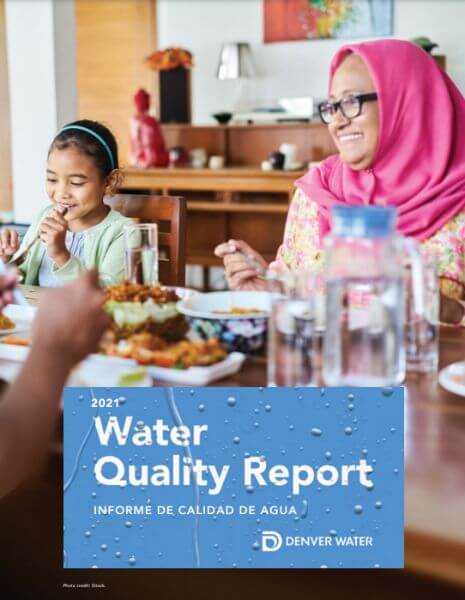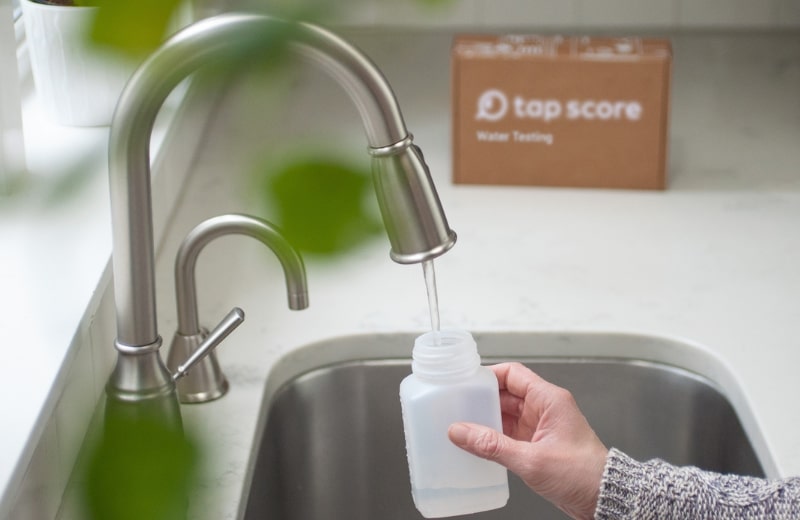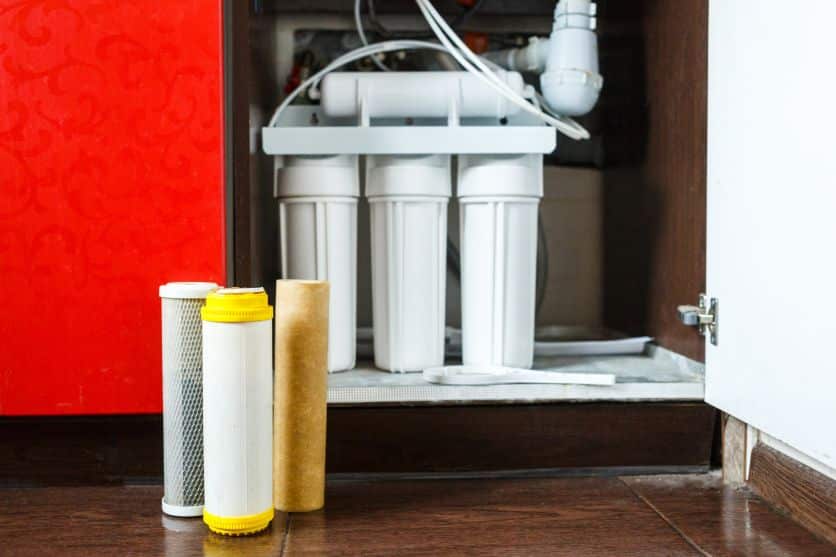Beryllium is a toxic metal that may cause damage to the bones, lungs, and digestive system if ingested in large amounts.
In this guide, we’ve shared everything you need to know about beryllium in drinking water, including what it is, how it gets there, its potential health effects, and how to detect it.
📌 Key Takeaways:
- Beryllium is a rare metallic element that occurs naturally in the ground.
- Electronics, aerospace, and mechanical industries all mine and use beryllium compounds along with other elements.
- Potential health effects of beryllium exposure in drinking water include lung disease, and damage to the liver, kidneys, heart, lymphatic system, and nervous system.
Table of Contents
- ❔ What Is Beryllium In Water?
- 🚰 How Does Beryllium Get Into Water?
- 🔎 How To Know If Your Water Contains Beryllium
- 🚱 Is Beryllium In Drinking Water Dangerous?
- 📉 Is Beryllium In Tap Water Regulated?
- 🧪 How To Test For Beryllium In Tap Water
- 👩🏽⚕️ What To Do If You’re Concerned About Beryllium In Your Water
- ⚠️ Other Ways You Might Be Exposed To Beryllium
- 📑 Final Word: Removing Beryllium From Water
❔ What Is Beryllium In Water?
Beryllium is a metal element that occurs in combination with other elements in the ground. Natural deposits of beryllium compounds are found in about 30 mineral species in various parts of the world.
This relatively rare element, known as “Be” on the Periodic Table, is found in rocks, sediments, soils, and fossil fuels.
Some of the most well-known beryllium-containing minerals are bertrandite (beryllium silicate) and beryl (beryllium aluminum silicate), which occur in rocks made from cooled, hardened lava. Some precious stones, including aquamarine and emerald, are also forms of beryl.
A chemical process is used to obtain beryllium in its industrial form from bertrandite or beryl. Beryllium is relatively soft and silver-gray in its isolated form.
Although beryllium compounds are found worldwide, the mining hub for the majority of this chemical element is Spor Mountain, Utah.
Beryllium processing produces beryllium oxide, beryllium alloys, and beryllium metal, which have different uses in different industries.
There are numerous uses for beryllium today, including:
- The aerospace industry (satellites, engines, gears, aircraft braking systems, etc.)
- Producing metal alloys for nuclear reactors
- The automotive industry (ignitions, anti-lock brake systems, etc.)
- The technology industry (telecommunications infrastructure equipment, phones, computer parts, etc.)

🚰 How Does Beryllium Get Into Water?
Beryllium gets into water by pollution, erosion of natural deposits, and deposition of beryllium from the atmosphere.
The main source of beryllium pollution is the burning of coal. Beryllium is found naturally in soils, but the disposal of industrial wastes containing beryllium, or combuster ash or coal ash, could increase the beryllium concentration in local soils.
Manufacturing facilities that use beryllium may also release this toxic metal into the atmosphere or nearby water sources due to runoff from waste disposal sites.
Rocks and soils containing beryllium may leach this metal into surface waters due to natural erosion and weathering.
Runoff from treated wastewater effluents containing beryllium is another source of water contamination, and atmospheric beryllium may also end up in surface waters due to natural settling of fly ash or rainfall.
There are various kinds of beryllium compounds found in the environment, and those that are water-soluble are considered the most dangerous to human health compared to insoluble compounds.
🔎 How To Know If Your Water Contains Beryllium
Beryllium doesn’t have a taste, smell, or color in water, so you’ll only know it’s present in your water through testing.
There are a few different ways that you can know if your home’s water contains beryllium:
Check Your Consumer Confidence Report
If you get your water from a municipal supplier, you can find out what it contains by checking your most recent Consumer Confidence Report.
A Consumer Confidence Report, or Water Quality Report, lists all the contaminants detected in a water supply, and how these compare to the EPA’s Maximum Contaminant Level or Maximum Contaminant Level Goals. This information is based on tests conducted by the water utility throughout the given year.
If your water utility has detected beryllium in your drinking water, it should be listed, along with the concentration range and average detected, in the Report.
You should be able to find your Consumer Confidence Report on your water utility’s website.

Test Your Water
You might be concerned about the accuracy of your Consumer Confidence Report, or you might get your water from a private well.
In any of these scenarios, we recommend getting your water tested for beryllium, which will give you the most accurate understanding of exactly how much beryllium it contains.
We’ve shared more on testing your water for beryllium later in this guide.

🚱 Is Beryllium In Drinking Water Dangerous?
Beryllium is considered dangerous in drinking water because it’s a toxic contaminant that has a number of known health risks.
Some of the health effects of beryllium include:
- Beryllium sensitization – An immune response that is activated due to beryllium exposure
- Chronic beryllium disease (CBD) – A lung disease causing shortness of breath, fever, fatigue, coughing, and weight loss
- Lung cancer
These conditions are more commonly caused by occupational exposure to beryllium, typically by inhalation of beryllium or skin contact with beryllium dust.
We currently don’t know much about the health effects of beryllium when ingested in drinking water. Beryllium is thought to increase the risk of cancer, and the International Agency for Research on Cancer assigned beryllium and beryllium compounds as carcinogenic to humans. A report by the World Health Organization (WHO) shared studies on laboratory animals that linked beryllium ingestion in water to:
- Gastrointestinal tract lesions
- Weight loss
- Gene mutations
Beryllium in tap water might also cause harm to the lungs and bones.

📉 Is Beryllium In Tap Water Regulated?
Beryllium in tap water is regulated by the Environmental Protection Agency under the Safe Drinking Water Act (SDWA).
The EPA established a Maximum Contaminant Level (MCL) of 4 PPB (parts per billion) of beryllium in tap water based on a study published in 1970.
Under these EPA regulations, water utilities must test their water for beryllium and reduce their water beryllium levels to 4 PPB or lower to provide water that’s legally safe to drink.
However, some organizations think that the MCL for beryllium should be much lower based on emerging evidence of its health risks.
The Environmental Working Group (EWG) is one such organization that has established its own non-enforceable Health Guideline of 1 PPB for beryllium in water, which it considers the “true” safe maximum amount of this contaminant.
🧪 How To Test For Beryllium In Tap Water
You can’t test for beryllium in your water with a standard at-home drinking water test. More advanced testing is required, so we recommend using a laboratory test for this contaminant.
To use a laboratory test for beryllium, follow these steps:
- Order a test online. A beryllium water test costs $30-$60.
- Take a water sample. When your test kit arrives, use the included equipment and follow the instructions to take a water sample.
- Ship your sample. Send the sample back to the laboratory and wait for your results (typically within 10-14 days).
- Analyze your results. The test data should tell you whether or not beryllium was detected, and the exact concentration of this contaminant in your water.
The presence of beryllium in water is often associated with radioactive elements and raw earth elements, so before you start searching for tests, find out everything you can about your water supply source, your local geology, and how the surrounding land is used. This is especially important if you get your water from a private well.

👩🏽⚕️ What To Do If You’re Concerned About Beryllium In Your Water
If you’re concerned about beryllium in your drinking water, you have a few options, depending on your situation:
- If trace amounts (below the EPA MCL) of beryllium were detected in your water, and you’re supplied by a local water utility, you can only install an at-home water treatment solution to remove beryllium.
- If your water test shows that beryllium is present above the EPA limit, contact your water supplier with a copy of the test results and ask them what they’re doing to reduce beryllium in your tap water.
- If you get your water from a private well and beryllium is detected above the EPA limit, you should also look at whole-house treatment systems to remove beryllium.
⚠️ Other Ways You Might Be Exposed To Beryllium
Beryllium exposure doesn’t only occur in drinking water. Other ways you might be exposed to this contaminant include:
- By breathing beryllium in the air – If you live near a mining or manufacturing facility that releases beryllium into the air, you’re at an increased likelihood of airborne exposure to this contaminant.
- By ingesting beryllium in foods – Certain foods, including field corn and carrots, contain natural beryllium deposits.
- By workplace exposure – Certain workplaces may expose you to higher-than-normal levels of beryllium.
📑 Final Word: Removing Beryllium From Water
Ingesting beryllium is dangerous, and luckily, there are a number of water treatment options for removing this contaminant from your drinking water.

Some of the best drinking water filtration methods for beryllium removal are:
- Reverse osmosis filtration system
- Ion exchange system
- Activated alumina filter
Many of these water treatment methods can remove other contaminants from your whole house’s water, too, giving you cleaner, purer, safer treated water.
Make sure to choose your preferred filtration system carefully. Always check customer feedback and reviews from industry experts before you spend your money.
